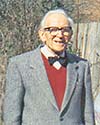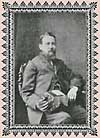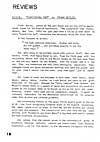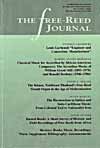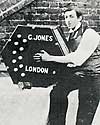|
Posted 15 January 2005
Frank Butler: An Interview
Richard Carlin
Frank Butler (Fig. 1) will hardly need an introduction to concertinists:
he was one of the twentieth century’s finest players of the English concertina, with a career
as a performer that spanned the 1920s–1940s; he was one of the most important teachers of the
instrument, which he taught for several decades in London's schools for adult-education; beginning
in the 1950s, he was a driving force in—and one of the founding members of—the
International Concertina Association, to which he devoted himself with his usual energy; and
he was evern a historian of the intrument, having contributed an informative article on the
behind-the-scenes business of concertina manufacturing in the nineteenth
century.1
In addition, Butler touched many concertinists with whom he never came into personal contact
through his fine tutor for the instrument, The
Concertina,2
which not only offers a comprehensive method for playing the instrument, but provides a primer
on the basic elements of music theory,
and thus reflects Butler's strongly held belief that concertinists
should be good, well-rounded musicians.
What follows is based on an interview that I conducted with Frank
Butler in January 1975.3
 Fig. 1. Frank Butler and Eileen
Fig. 1. Frank Butler and Eileen
Jones in Frank’s garden, 1991.
Frank E. Butler was born in March 1904,4
the youngest of three children. His formal education came to an end when he was fourteen, at which
time he was apprenticed to a wholesale drapers for two-and-a-half years. He then spent the remainder
of his working life in the employ of a publisher that specialized in school textbooks, rising from
book packer to the important post of advisor on educational publishing. Frank began his musical career as
a pianist:
My mother made efforts to teach me the piano, not very successfully because
she belonged to the ‘spare the rod and spoil the child’ fraternity, and
therefore she was quite harsh in her teaching. But when I was sixteen-and-a-half, I
suddenly took to it on my own account, except that if my mother walked in to play, I walked
out. I wasn’t having the risk of another cuff!
Frank taught himself to play the piano and read music by using the Trinity College of Music
examinations for the piano as a guide. Before long, he was touring as a pianist with a
‘concert party’, that is, a group of musicians who normally joined forces with
a comedian, singer, and Master of Ceremonies to perform at local clubs. Most of the
members of the party were employed in regular day jobs, and used their party performances
in order to earn a bit of extra money on the side.
Frank’s interest in the concertina was inspired by the memory of his
grandfather, the well-known concertina
manufacturer George Jones.5
My grandfather, George Jones, was a manufacturer of concertinas. I
can’t tell you from memory when he started in the business; I think he gave
up around 1910. He started as an out-worker for Wheatstone’s. He joined
with another outworker of Wheatstone’s [Jabez Austin] in some sort of
partnership. … My grandfather [joined Austin] at the age of twenty, as
manager, which was a pretty hectic rise for those days, and [within a year, Austin]
had drunk himself to death. So my grandfather found himself in possession of
quite a good-sized music business. …
Two of Jones’s students would play a crucial role in Butler’s career:
Arthur and Joseph Webb. Better know as the ‘Brothers Webb’ (Arthur as
Root-Toot, or Ruté, as it was sometimes spelled, Joseph as Jo-Jo), they were
among the most popular musical circus clowns of the late nineteenth and early
twentieth centuries, and also played the music halls and clubs that were, at the time,
ubiquitous throughout England. And in addition to their fiddle, musical saw, and drum
(not to mention their feats of acrobatics, juggling, and comic skits), the brothers
played concertinas in the course of their act. Moreover, since the circuses of the period
offered Sunday concerts of semi-classical music, the brothers had an opportunity to show
off their concertina-playing skills, Arthur on the treble, Joseph on the
baritone.6
It was the Webb brothers who encouraged Frank to take up the concertina in the late
1920s, when frank was twenty-five years old:
The brothers Webb said, ‘What an appalling thing it is that
Frank, the only one of the Jones brood that seems to have gone truly musical,
doesn't play a concertina.’ My grandfather, of course, was dead. My
grandmother had two of his instruments, not very good ones, so the
brothers Webb lent be a treble English ‘tina; and, in all honesty, I can
say that within six weeks I was using it on the stage; I was playing
Dvořák’s ‘Humoresque’ and Beethoven's ‘Minuet
in G’, and they remained my stock solos for three months. …
At that time, light-classics such as those mentioned by Frank, along
with selections from operas, marches by Sousa, and popular songs of the
day were the meat-and-potatoes of the concertinist’s repertory. This was
the music that people wanted to hear in the music halls, and this was what the
professionals played.
Frank used the concertina as a ‘novelty’ to perform one or
two solos as part of a concert party. And though Frank never became, in his
words, ‘a full-time, professional “artiste”’, he was
able to find a good deal of work, since opportunities for semi-professional
performers at this time were numerous:
A lot of churches used to run regular concerts. There wasn’t the
radio or television … the clubs, the working-men’s clubs, and so forth,
were all in existence and all had regular concerts. I don’t know that they
have the same now; I believe they switch the television on and leave it at that. Several
cinemas were not allowed to open on Sundays unless it was a ‘concert’. So by
some weird logic, if you put on two films and a short program of music in between, it
became a ‘concert’. And that was legal! With some concerts, it was lethal,
I should think! That provided us with Sunday night jobs, and some of them were very well
paid. This work was not limited to London, and we used to go far afield for those days:
Folkestone, Cambridge, Bedford, Luton … it meant, very often, not getting home
until 2:00 in the morning, which will tell you why I didn’t want to do any more
than three a week.
In the early years of the Depression, Frank’s concert party broke up, and
he began to tour as a solo artist. He limited his solo work to the concertina, and he
soon had well over thirty numbers under his fingers. Yet Frank found performing unrewarding:
I went on to working solo turns, and my heart really wasn’t in it. The
people wanted popular chorused, and they wanted 'ditties' that they could sing, and I got
no pleasure out of playing the concertina while eight hundred to a thousand people bawled
choruses at me. … I had some thirty numbers in my repertory then, which I knew from
memory, and I knew [them] so well that I could carry on a conversation at the same time I was
playing them. I always had a selection going of the popular songs of the day. Funny enough,
the only ones that comes to mind immediately [are] ‘If I Had A Talking Picture of You’
and ‘Sonny Boy’, that sort of thing. I also had several selections of old music
hall choruses; these would always go down well, particularly in the clubs. Truthfully, I
didn’t like playing them, but this was your only way to get encores. In the end,
I didn’t care whether I got an encore or not; that’s why I gave up.
Frank put away his concertina until after the Second World War. In the meantime,
his wife had encouraged him to take up the piano again, which, as it turned out, led him to
playing classical music on the concertina. In 1953, the grandly-named International Concertina
Association—really at first just a London-based group of players—was formed. Frank
attended his first meeting a year later, and became the Association’s secretary in 1955,
editing the ICA Newsletter from 1956 to 1967. Frank also organized the ICA’s first
festival, which subsequently developed into a yearly competition aimed at encouraging young
players to take up the instrument. Finally, he began teaching group classes at various
London-area ‘Institutes’ (schools run by the individual boroughs and devoted
to adult-education), which he would continue to do through the late 1970s:
Harry Minting [the last manager of the Wheatstone firm, and a concertina
player and teacher active in London for many decades] started this school [in the early
1950s] …. He recruited so many students it became a little bit of a problem, and
he engaged me to take his beginners&rsqo; classes. He had two classes. And this really
got me deep into teaching. I’d only done it in a desultory fashion up to then. I
decided immediately that there was nothing published that met my requirements, [so] I
wrote the exercises myself, and that, in 1955, was the beginning of the Butler tutor.
… Minting after a time transferred his club to the Holloway Institute, where I
teach now [1975]. Minting himself became ill, and I stepped in as his substitute, his
deputy, and was quite happy over it. … And [when, in 1959,] Minting … decided
to give that up entirely … [he] asked me if I would like to take the class. And
I took this class over from him, really, on a few hours notice. And I’m not in my
sixteenth year of it.
One year before that [thus in 1958], Battersea Institute started a class
of concertina playing at the request of an old gentleman in the borough who asked the
principal in he could have a class. And the principal said, ‘If you can get
sufficient students, yes’. The old gent advertised in all the local papers, put
little notices in the local shops, and he recruited a class. The principal of Battersea
Institute engaged me as the teacher. So there I was with Battersea Institute, substituting
for Minting at Holloway, and then [after Minting left] I found myself with Holloway
Institute as well. And from that moment, for many years I reigned supreme as the
only accredited teacher of the English concertina, with two of London’s Institutes
to work in.
Butler soon discovered that many of his students could not read music, so he
designed a course of study that would teach the basics of reading music while it
developed exercises that would help students understand the unique layout of the
English concertina&rsquo's keyboard. Like the Trinity method with which he had taught
himself, Frank’s method was based on taking the students from elementary scales
and exercises to the most difficult classical music. He also drew on his experiences
developing textbook material for beginning readers. Butler’s method was based
on constantly challenging the student with a wide variety of graded material:
To me, the most important thing in playing was sight-reading. When
you’re teaching an infant at school to read, you don’t give him one book,
and let him read that until he can read it perfectly. [Better to have him] read
something different every time he opens a book. You get some repetition, but on the
whole, the child’s reading capacity is being expanded the whole time.
And I work very much the same [way] with music. I’m very
anxious to get these pupils to the stage where they can read music as fluently
as you or I read a newspaper or a novel. As in reading [a] text, you start
off with a small vocabulary and gradually expand it, so with music you start off
with one note and expand it until you’ve got twelve different pitches, and
four different variations of duration. And when you’ve acquired that much,
you’ve already opened an enormous field to explore, because all of your simple
folk or traditional tunes lay within your grasp. I aim that within two years the
concertina player will be a fluent reader and have considerable dexterity in playing.
A brilliant player will go through my course in eight months; I shouldn’t think
I’ve seen this more than about three times in fifteen years, but it’s done.
Sadly, by the early 1970s, Butler›s eyesight was failing, and he had
to wait several years to get the operation that he needed through Britain’s
National Health system. Still, he continued to teach through the early 1980s.
Fortunately, the concertina revival of the mid-1970s—based mainly in England—brought
him to the attention of a new generation of players, and with the publication of his
instruction book, his method of teaching spread widely and quickly. Although Butler
was himself primarily interested in the ‘classics’, he was whole-heartedly
sympathetic to all styles of music, and his teaching gave students a strong foundation
for playing in any style they wished.
Honored and admired by all who knew him, Frank Butler—a gentle
man with a wonderful sense of humor—passed away on
21 February 1992.7
Have feedback on this article?
Send it to the author.
The original version of this article appeared in
Papers of the International Concertina Association (PICA),
Vol. 1 (2004), pp. 24–30. PICA is published by
The International Concertina
Association (ICA)
and
The Center for the Study
of Free-Reed Instruments (CSFRI)
at The Graduate Center of The City University of New York.
Reprinted from the Concertina Library
http://www.concertina.com
© Copyright 2000– by Richard Carlin
|

Frank Butler and Eileen Jones
in Frank’s garden, 1991
Contents
- Frank Butler: An Interview
- Notes
The original version of this article appeared in
Papers of the International Concertina Association (PICA),
Vol. 1 (2004), pp. 24--30. PICA is published by
The International Concertina
Association (ICA)
and
The Center for the Study
of Free-Reed Instruments (CSFRI)
at The Graduate Center of The City University of New York.
© 2005 Richard Carlin.
Links to related documents
-
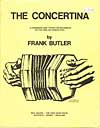 The Concertina: A Handbook and Tutor for Beginners on the English Concertina
The Concertina: A Handbook and Tutor for Beginners on the English Concertina
-
by Frank E. Butler
- The standard tutor for the English concertina during
the concertina revival in the 1970s. Based on classes offered at the Battersea
Institute under the auspices of the Inner London Education Authority. Introduction
to music, exercises, and elementary tunes.
Originally published by Neil Wayne at the Free Reed Press,
Duffield, Derby, England, in 1974. 64pp plus covers. The scan was made by
Wes Williams.
-
Posted 15 January 2005
-
» read full document in pdf
-
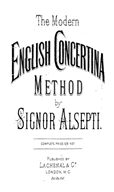 Instruction Manuals for the English, Anglo, and Duet Concertina: An Annotated Bibliography
Instruction Manuals for the English, Anglo, and Duet Concertina: An Annotated Bibliography
- by Randall C. Merris
-
A comprehensive bibliography with more than 200 citations for
concertina tutors that were published from the 1840s to the present.
Separate sections deal with English, Anglo, and Duet tutors.
The annotations contain
considerable historical material on concertina makers, authors and teachers, performers,
and publishers in the UK, US, and elsewhere. The web version incorporates citations for tutors
that have appeared or were located subsequent to the original publication (about 35 more by 2005)
and adds over 100 scanned photographs of tutor covers.
A number of the tutors are available scanned
in full on this website, and these are indicated in the entries.
The original publication was in The Free-Reed Journal 4 (2002): 85-118,
and a PDF version of the printed article is also available online.
- Posted 01 April 2003; last updated 31 August 2005
- » read full article
- » read Part 1, "English Concertina"
- » read part 2, "Anglo Concertina"
- » read part 3, "Duet Concertina"
- » read original article (without updates) in pdf"
-
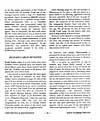 Richard Carlin Revisited
Richard Carlin Revisited
-
by Frank E. Butler
- Frank Butler recalls his interview with Richard Carlin twelve years before, and
also mentions many of the early ICA figures.
As published in Concertina & Squeezebox, No. 20 (Summer 1989), p 21.
-
Posted 15 January 2005
-
» read full document in pdf
-
 The Fayre Four Sisters: Concertina Virtuosi
The Fayre Four Sisters: Concertina Virtuosi
-
by Richard Carlin
- Interviews with Inga, Tina, Sylvia, and Lillian Webb, the “Fayre
Four Sisters,” concertinists on the British music hall and vaudeville circuits.
The sisters were daughters of Joseph Webb (JoJo of the Brothers Webb), and part of
the circle including George Jones, who gave them their first concertina lessons, and
of Frank Butler.
As published in The Free-Reed Journal No. 3 (2001), pp 79–88.
-
Posted 15 January 2005
-
» read full article
-
» read full article in pdf
-
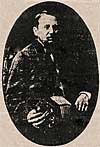 Recollections of the English Concertina, from 1844,
by George Jones, born February 29th 1832
Recollections of the English Concertina, from 1844,
by George Jones, born February 29th 1832
-
by George Jones
-
A full transcription of a manuscript now in the British Library, catalogued there as:
Additional Manuscript 71124 Q,
Recollections of the manufacture of the English concertina from 1844, by George Jones; [1912].
Presented by F. E. Butler, Esq., grandson of George Jones, 29 Aug. 1988, and incorporated in 1993.
ff. 331 x 207mm.
As published in Concertina Magazine, 13 (Winter 1985): 4–5, and
14 (Spring 1985): 4–7. Previously published (with heavy editorial additions) in
FreeReed: The Concertina Magazine, No. 16 (November 1973): 14–20.
A link is provided to PDF scanned versions of both publications.
-
Posted 15 January 2004
-
» read full article
-
» read 1985 publication in PDF
-
» read 1973 publication in PDF
-
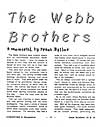 The Webb Brothers: A Memorial
The Webb Brothers: A Memorial
-
by Frank E. Butler
- An account of the great two musical clowns who learned to play
concertina from George Jones, grandfather of Frank Butler (the author).
The elder brother, Joe Webb, was in turn the father of the Fayre Four Sisters,
concertinists.
As published in Concertina & Squeezebox, No. 18-19 (1989), pp 11-15.
Also published in Concertina Magazine (Australia), 24 (1988), 6-8.
-
Posted 15 January 2005
-
» read full document in pdf
|



